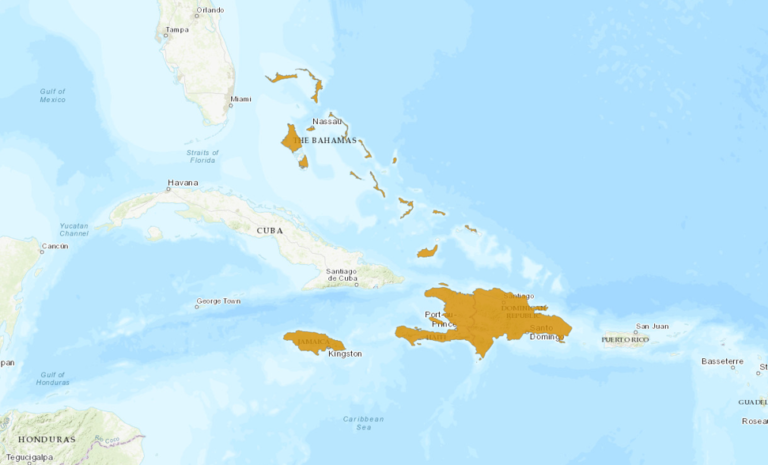Birdfinding.info ⇒ Widespread, common, and generally easy to find, but not always easy to see, as it habitually remains in dense cover and often sings from inconspicuous perches. Usually present at the frequently visited woodland sites on Jamaica and most major islands in the northern and central Bahamas, including Grand Bahama, Abaco, Andros, New Providence, Eleuthera, Cat Island, Exuma, and Long Island—but generally rare in the southern Bahamas and Turks & Caicos. Locally common on Hispaniola, where it can often be found in the vicinity of the major resorts at Punta Cana and La Romana, as well as foothill and mountain sites such as the Rabo de Gato Trail, Zapotén, and Ébano Verde.
Greater Antillean Bullfinch
Melopyrrha violacea
Endemic to the West Indies: the Bahamas, Turks & Caicos, Jamaica, Hispaniola, and adjacent smaller islands (Gonâve, Tortue, Île-á-Vache, Beata, Catalina, and Saona), where it is generally common and widespread in woodland and scrub habitats, both wet and dry, at most elevations.
Traditionally divided into five subspecies: violacea throughout the Bahamas; ofella on the Caicos Islands; maurella on Tortue; affinis on Hispaniola, Gonâve, Île-á-Vache, Beata, Catalina, and Saona; and ruficollis on Jamaica.
Identification
A large, black bullfinch with vivid rufous markings on the brow, throat, and vent.
Depending on the lighting, these markings may appear bright red, pale orange, dull chestnut, or anywhere in between.
The sexes are similar except that males are jet-black, whereas females tend to appear either duller black or sometimes paler and grayish.
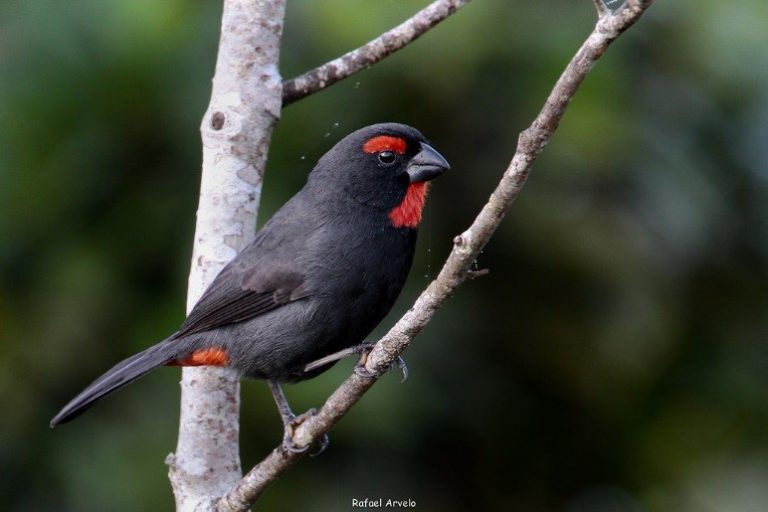
Greater Antillean Bullfinch, M. v. affinis. (Monseñor Nouel, Dominican Republic; December 5, 2011.) © Rafael Arvelo

Greater Antillean Bullfinch, M. v. affinis. (Sierra de Bahoruco, Dominican Republic; May 17, 2016.) © Dax M. Román E.
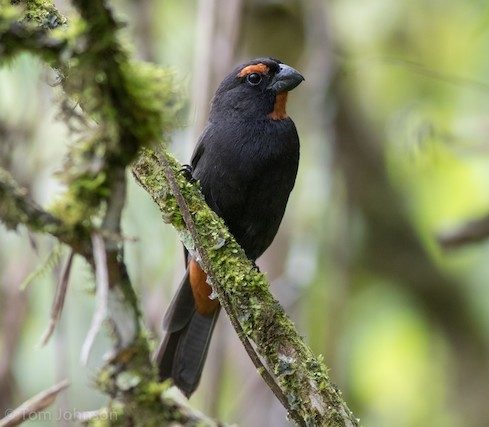
Greater Antillean Bullfinch, M. v. ruficollis. (Stewart Town, Jamaica; March 9, 2018.) © Tom Johnson

Greater Antillean Bullfinch, M. v. violacea. (Central Abaco, Bahamas; January 8, 2013.) © Christoph Moning
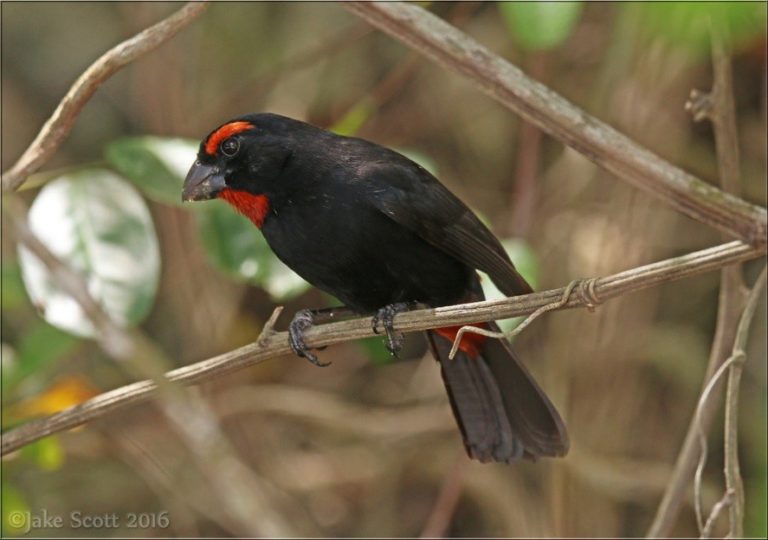
Greater Antillean Bullfinch, M. v. affinis. (Isla Catalina Natural Monument, Dominican Republic; May 3, 2016.) © Jake Scott
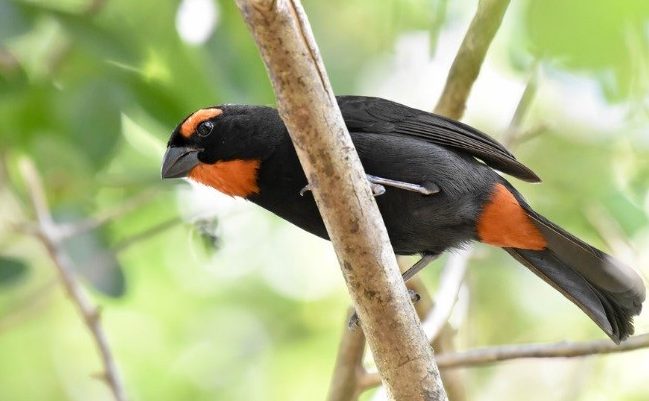
Greater Antillean Bullfinch, M. v. affinis. (La Altagracia, Dominican Republic; February 13, 2018.) © Sadik Kassam
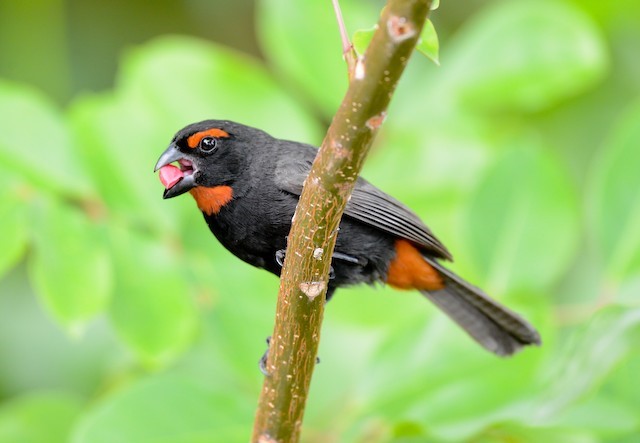
Greater Antillean Bullfinch, M. v. violacea. (Highborne Cay, Bahamas; June 13, 2015.) © Erik Martin
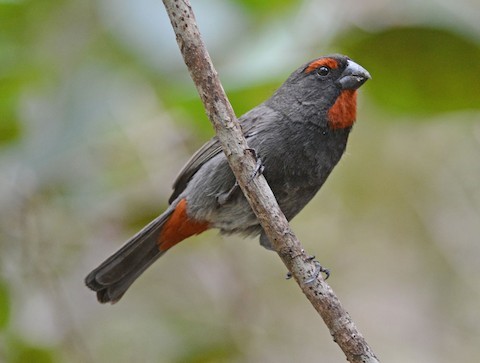
Greater Antillean Bullfinch, M. v. violacea, presumably a female. (North Andros, Bahamas; April 19, 2017.) © Mark van Beirs

Greater Antillean Bullfinch, M. v. violacea. (Rainbow Bay, Eleuthera, Bahamas; May 9, 2018.) © John Mackin
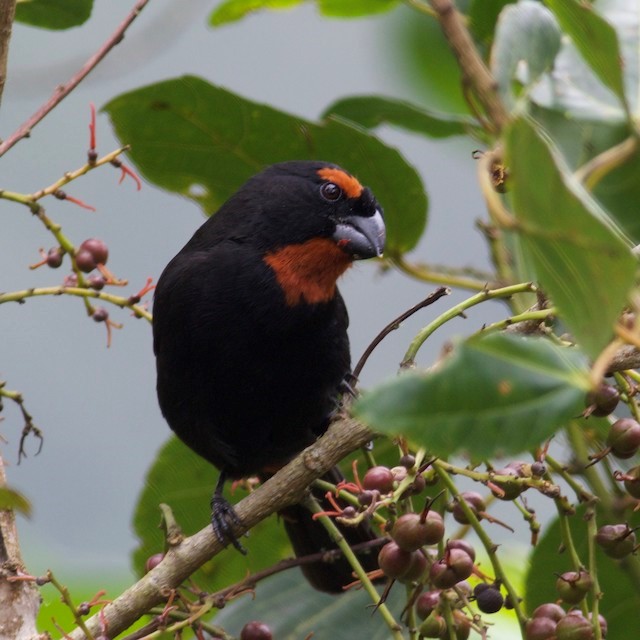
Greater Antillean Bullfinch, M. v. ruficollis. (Woodside Track, Hardwar Gap, Jamaica; May 1, 2017.) © Nick Lessof

Greater Antillean Bullfinch, M. v. violacea. (Basseterre, Exuma, Bahamas; March 24, 2018.) © Harold Brewer
Immatures are similar to adults but their predominant coloration varies from tan to various shades of brown, to blackish. They develop the adults’ rufous markings in stages, with the brow becoming noticeable first and the throat last.
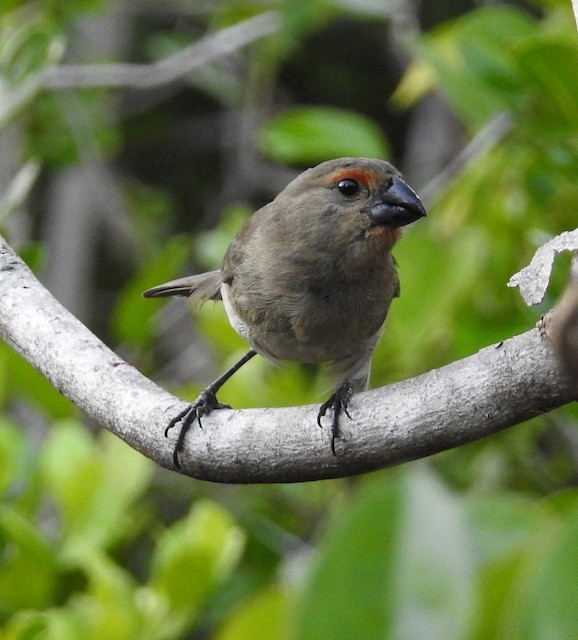
Greater Antillean Bullfinch, M. v. violacea, immature. (Garden of the Gates, Grand Bahama; November 19, 2017.) © Erika Gates
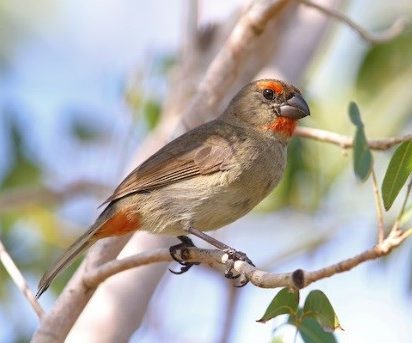
Greater Antillean Bullfinch, M. v. violacea, immature. (Marsh Harbour, Abaco, Bahamas; January 11, 2013.) © Christoph Moning
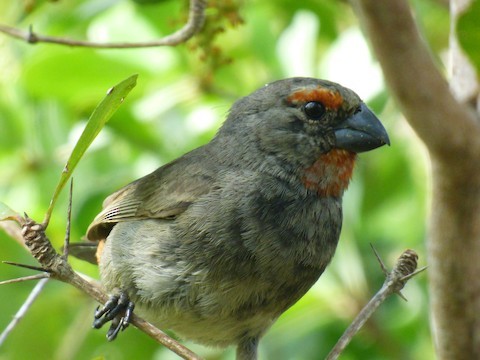
Greater Antillean Bullfinch, M. v. violacea, immature beginning molt into adult plumage. (Matthew Town, Great Inagua, Bahamas; February 19, 2017.) © Tarra Lindo
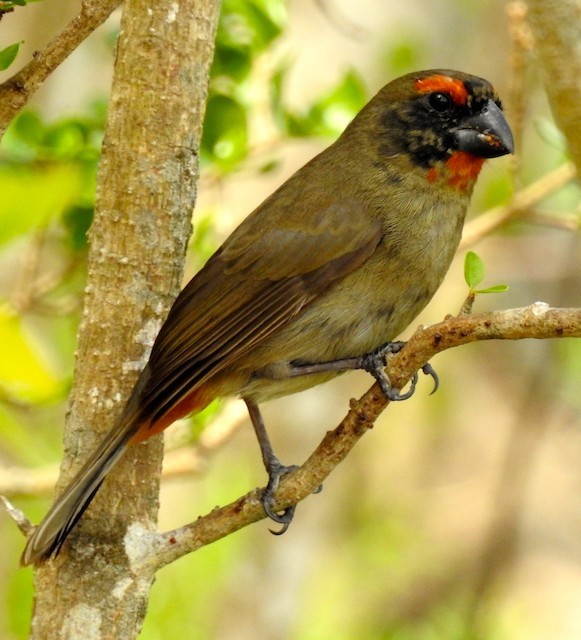
Greater Antillean Bullfinch, M. v. violacea, molting into adult plumage. (Garden of the Gates, Grand Bahama; February 18, 2017.) © Erika Gates

Greater Antillean Bullfinch, M. v. ruficollis, immature. (Ecclesdown Road, Jamaica; October 12, 2010.) © Ron Orenstein
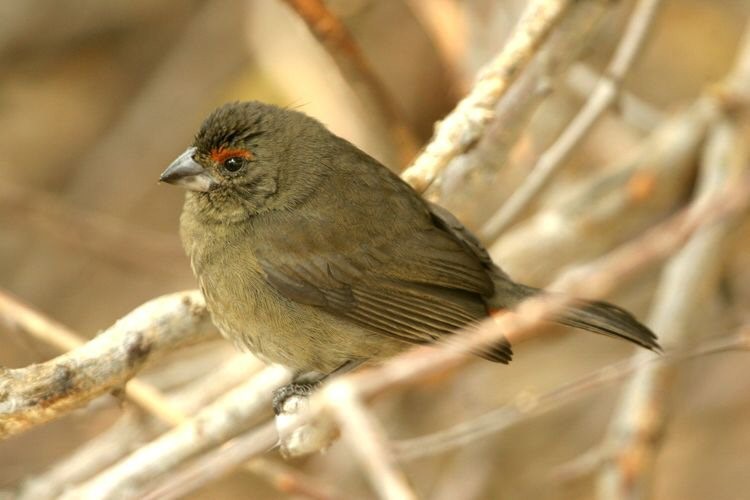
Greater Antillean Bullfinch, M. v. affinis, immature. (La Romana, Dominican Republic; January 2005.) © Giuliano Gerra and Silvio Sommazzi
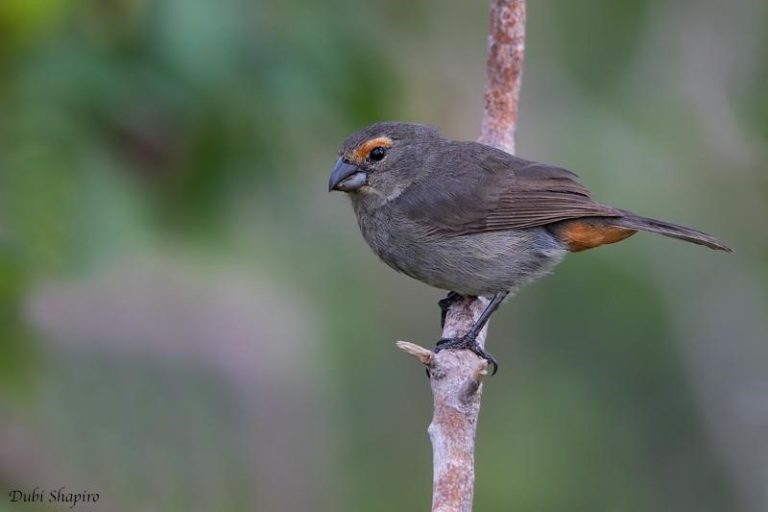
Greater Antillean Bullfinch, M. v. ofella, immature. (Inagua, Bahamas; November 22, 2017.) © Dubi Shapiro

Greater Antillean Bullfinch, M. v. violacea, immature. (Seymours, Long Island, Bahamas; October 26, 2017.) © Scott Fischer
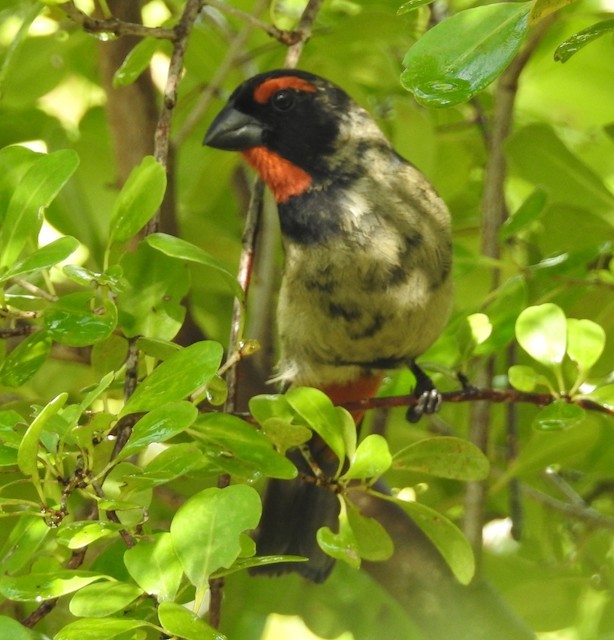
Greater Antillean Bullfinch, M. v. violacea, molting into adult plumage. (Garden of the Gates, Grand Bahama; May 14, 2018.) © Erika Gates
Voice. Most calls are thin, high-pitched whistles, sometimes clear and sometimes wheezy.
Typical song is an accelerating series of whisteled notes: Songs can vary in tone and phrasing, including paired notes and twittering:
Cf. Lesser Antillean Bullfinch. Greater Antillean and Lesser Antillean Bullfinches are very similar. They do not occur together naturally, but Lesser Antillean is a notably tame species whose habits could lead to inter-island transport via cruise ship.
The male Lesser Antillean strongly resembles Greater Antilleans of both sexes, with the principal differences being the size of the bill and the length of the chestnut eyebrows. Greater Antillean’s bill is usually larger, with a deeper base, and its brows are thicker and longer, extending behind the eye. Greater Antillean is somewhat larger and more elongated than Lesser Antillean. Both species are variable and there may be some overlap in bill size.
Notes
Polytypic species consisting of five recognized subspecies: violacea, ofella, maurella, affinis, and ruficollis. The validity of some of these plus a putative sixth subspecies, parishi, has been questioned.
References
BirdLife International. 2016. Pyrrhulagra violacea. The IUCN Red List of Threatened Species 2016: e.T22723628A94826555. https://dx.doi.org/10.2305/IUCN.UK.2016-3.RLTS.T22723628A94826555.en. (Accessed March 25, 2021.)
eBird. 2021. eBird: An online database of bird distribution and abundance. Cornell Lab of Ornithology, Ithaca, N.Y. http://www.ebird.org. (Accessed March 25, 2021.)
Haynes-Sutton, A., A. Downer, R. Sutton, and Y.-J. Rey-Millet. 2009. A Photographic Guide to the Birds of Jamaica. Princeton University Press, Princeton, N.J.
Kirwan, G.M., A. Levesque, M. Oberle, and C.J. Sharpe. 2019. Birds of the West Indies. Lynx Edicions, Barcelona.
Latta, S., C. Rimmer, A. Keith, J. Wiley, H. Raffaele, K. McFarland, and E. Fernandez. 2006. Birds of the Dominican Republic and Haiti. Princeton University Press, Princeton, N.J.
Raffaele, H., J. Wiley, O. Garrido, A. Keith, and J. Raffaele. 1998. A Guide to the Birds of the West Indies. Princeton University Press, Princeton, N.J.
Xeno-Canto. 2021. Greater Antillean Bullfinch – Loxigilla violacea. https://www.xeno-canto.org/species/Loxigilla-violacea. (Accessed March 25, 2021.)

